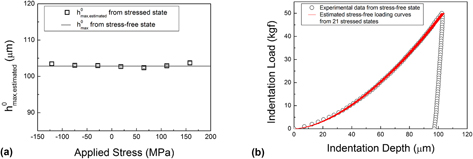Crossref Citations
This article has been cited by the following publications. This list is generated based on data provided by
Crossref.
Goto, Kenta
Watanabe, Ikumu
and
Ohmura, Takahito
2020.
Inverse estimation approach for elastoplastic properties using the load-displacement curve and pile-up topography of a single Berkovich indentation.
Materials & Design,
Vol. 194,
Issue. ,
p.
108925.
Hościło, Bogusław
and
Molski, Krzysztof L.
2020.
Determination of Surface Stresses in X20Cr13 Steel by the Use of a Modified Hardness Measurement Procedure with Vickers Indenter.
Materials,
Vol. 13,
Issue. 21,
p.
4844.
Peng, Guangjian
Xu, Fenglei
Chen, Jianfeng
Hu, Yahao
Wang, Huadong
and
Zhang, Taihua
2020.
A cost-effective voice coil motor-based portable micro-indentation device for in situ testing.
Measurement,
Vol. 165,
Issue. ,
p.
108105.
Peng, Guangjian
Xu, Fenglei
Chen, Jianfeng
Wang, Huadong
Hu, Jiangjiang
and
Zhang, Taihua
2020.
Evaluation of Non-Equibiaxial Residual Stresses in Metallic Materials via Instrumented Spherical Indentation.
Metals,
Vol. 10,
Issue. 4,
p.
440.
Kim, Kyung Il
and
Cho, Gue Serb
2021.
Development of Pre-stress Evaluation Technology for Cold Forging Molds Using Instrument Indentation Technique.
Journal of the Korean Society of Manufacturing Technology Engineers,
Vol. 30,
Issue. 6,
p.
441.
Jeong, Chanyoung
Hwang, Yewon
Kim, Naksoo
Lee, Cheolsoo
and
Lee, Hyungyil
2021.
Evaluation of equi-biaxial residual stress from spherical indentation imprint.
International Journal of Mechanical Sciences,
Vol. 211,
Issue. ,
p.
106773.
Kwon, Oh Min
Kim, Jiyeon
Lee, Jinwoo
Kim, Jong-hyoung
Ahn, Hee-Jun
Kim, Ju-Young
Kim, Young-Cheon
and
Kwon, Dongil
2021.
Compressive Properties of Nanoporous Gold Through Nanoindentation: An Analytical Approach Based on the Expanding Cavity Model.
Metals and Materials International,
Vol. 27,
Issue. 10,
p.
3787.
Peng, Bo
and
Ye, Duyi
2022.
Assessing the Residual Stresses in Dissimilar Welded Joint: Depth-Sensing Indentation Testing and Numerical Simulation.
Metals and Materials International,
Vol. 28,
Issue. 11,
p.
2798.
Xue, He
Yang, Yong-Jie
Zhang, Shun
Zhang, Yu-Biao
Shi, Zhe-Ren
Wang, Zheng
and
Zhang, Jia-Qing
2023.
Determination of residual stresses in metallic materials based on spherical indentation strain.
Materials Testing,
Vol. 65,
Issue. 7,
p.
982.
Fan, Xizhi
Luo, Zhangji
Mao, Weiguo
Deng, Xixing
Ye, Wenjie
and
Dai, Cuiying
2023.
Effect of heat treatment on hardness and fracture toughness of Si/BSAS/Yb2SiO5 EBCs system under 1200 °C.
Ceramics International,
Vol. 49,
Issue. 14,
p.
22654.
Cao, Taifeng
Su, Peng
Xu, Zhiheng
Feng, Zeqiang
Wang, Shaohua
and
Qiao, Junwei
2023.
Evaluation of residual stress in lead frame copper strips by nanoindentation.
Journal of Materials Science,
Vol. 58,
Issue. 13,
p.
5884.
Moon, Seongin
Choi, Minjae
Hong, Seokmin
Kim, Sung-Woo
and
Yoon, Minho
2024.
Non-equibiaxial residual stress evaluation methodology using simulated indentation behavior and machine learning.
Nuclear Engineering and Technology,
Vol. 56,
Issue. 4,
p.
1347.
Al-Zahrani, Eissa S.
Ogunlakin, Nasirudeen
Toor, Ihsan Ulhaq
and
Djukic, Milos B.
2024.
Hydrogen-induced cracking of longitudinally submerged arc welded HSLA API 5L X65 carbon steel pipeline.
Engineering Failure Analysis,
Vol. 163,
Issue. ,
p.
108561.
Kim, Jong-hyoung
Kwon, Oh Min
Lee, Junsang
Son, Hae-Jin
Kim, Young-Cheon
and
Kang, Seung-Kyun
2024.
Equivalent-Volume Model: Estimating Contact Morphology of Spherical Indentation for Metallic Materials.
Metals and Materials International,
Vol. 30,
Issue. 3,
p.
714.
Han, Giyeol
Lee, Bohyun
Lee, Sihyung
Jeong, Chanyoung
and
Lee, Hyungyil
2024.
Evaluation of plastic properties and equi-biaxial residual stress via indentation and ANN.
Materials & Design,
Vol. 239,
Issue. ,
p.
112745.
Peng, Guangjian
Li, Saifei
Zhang, Liang
Chen, Peijian
Xiong, Wei
and
Zhang, Taihua
2024.
An Instrumented Sharp Indentation Method for Measuring Equibiaxial Residual Stress without Using Stress-Free Specimens.
Acta Mechanica Solida Sinica,
Lee, So-Hyeon
Lee, Junsang
Kim, Younghoon
and
Kim, Ju-Young
2024.
Surface residual stress in H-section steel beams processed by quenching and self-tempering using instrumented indentation testing.
Journal of Materials Research and Technology,
Vol. 32,
Issue. ,
p.
177.
Vaidyanathan, S.
and
Schajer, G. S.
2024.
Determining Residual Stress Using Indentation and Surface Displacement Measurement.
Experimental Mechanics,
Vol. 64,
Issue. 8,
p.
1249.
Gao, Feinong
Xie, Lijing
Peng, Mingjian
Sun, Ting
Li, Xingyu
Pang, Siqin
and
Wang, Xibin
2024.
Micro-mechanical properties characterization of shot peening strengthened layer with nanoindentation.
Mechanics of Materials,
Vol. 197,
Issue. ,
p.
105072.
Han, Zhi
Jiang, Hanyang
Dong, Chenyong
Zhang, Liang
Peng, Guangjian
and
Zhang, Taihua
2025.
Instrumented indentation methods for measurement of residual stresses in thin films/coatings: a review.
Journal of Coatings Technology and Research,
Vol. 22,
Issue. 2,
p.
581.



